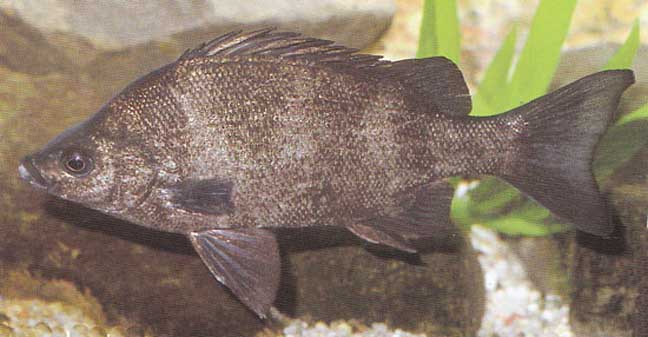Lake Grunter, Variichthys lacustris (Mees & Kailola 1977)

Lake Grunter, Variichthys lacustris. Source: Neil Armstrong. License: all rights reserved
Summary:
See 'More Info' tab
Cite this page as:
Martin F. Gomon, Variichthys lacustris in Fishes of Australia, accessed 24 Apr 2024, https://fishesofaustralia.net.au/home/species/705
Lake Grunter, Variichthys lacustris (Mees & Kailola 1977)
More Info
|
Distribution |
Occurs in the Mitchell River flowing into the Gulf of Carpentaria, QLD (16°24'S) and in southern New Guinea; a tropical species inhabiting mainly still freshwater in small lakes, overflow lagoons and swampy areas with plentiful vegetation. |
|
Features |
D XII–XIV, 10-11; A III, 8-9; P 14-15; V I, 5; LL 55-66; Trv Sc 9–11/l/20–22; GR 4–7 + 1 + 10–12 = 16-20; Vert 11+14. Body deep, 2.4-2.7 in standard length, ovate, only slightly compressed Head 2.6-3.5 in standard length; anterior profile from tip of snout to first dorsal spine almost straight. Snout bluntly pointed. Nostrils well-separated, the anterior one midway between tip of snout and eye or very little closer to till of snout, in line with the lower edge of the pupil when the mouth is closed; posterior nostril in line with middle of eye, and usually slightly nearer to eye than to anterior nostril. Eye of moderate size, 3.4-4.4 in head, 0.9-1.2 in snout and 0.9-1.3 in interorbital. Mouth rather small, below level of eye; when mouth closed; maxillary just reaching to vertical through anterior border of eye; lips moderately fleshy; dentition well-developed, upper jaw with outer row of 9-13 strong conical fixed (non-depressible) teeth on each side, larger near symphysis; second row of smaller teeth, followed by 2 irregular rows of still smaller teeth; similar dentition in lower jaw but more (about 16) teeth on each side of outer row; all teeth colourless, but with tips ranging from pale yellow through orange to dark brown; no teeth on tongue, vomer or palatines; lower edge of preorbital straight to slightly curved, with 8-10 strong teeth, covered with thick pigmented skin in larger specimens, but readily apparent in smaller specimens; entire free border of preoperculum serrated with 22-30 colour-less serrae, which are strong and sharp, scarcely thicker at the bend; operculum ending in 2 flat spines not extending beyond border of soft operculum; posterior border of postcleithral process free, with 6-10 serrae; supracleithrum not externally visible. Scales finely ctenoid; lateral line continuous, smoothly curved; scales below lateral line 58-67, above lateral line 66-74. Dorsal fin continuous, base; spinous portion arched; first spine short; sixth longest, longer than longest dorsal rays, spines following longest dorsal spines decreasing in length to penultimate, which is shorter than last. Second anal spine longest, about equal to longest anal rays; soft anal fill truncate. Pelvic fins reaching to or even a little beyond anus in smaller fish, but short of anus in larger fish. Pectoral fins rounded to lanceolate. Caudal fin shallowly forked. |
|
Size |
To 17 cm SL, commonly to 10 cm. |
|
Colour |
Uniformly yellowish brown to brown, without markings, darker dorsally, almost blackish on upper half of head and area from nape to dorsal origin; ventral surface from chin to base of caudal fin creamy white or pinkish. Fins overall same brown as body, but tips of membrane between dorsal spines dark, and last dorsal and anal rays hyaline; pectoral fins paler than body; posterior margin of caudal fin dark brown. |
|
Feeding |
Herbivorous, feeding mainly on algae. |
|
Biology |
Little is known of the reproductive biology of this species, however it is likely it produces demersal eggs that attach to the substrate. |
|
Etymology |
The generic name is an amalgam of the surname of Richard Vari, a major revisor of the family, and the Latin ichthys for fish, in recognition of the authors contribution to our knowledge of fishes. The specific name lacustris is Latin for pond or lake, the preferred habitat for this species. |
|
Species Citation |
Therapon lacustris Mees, G.F. & Kailola, P. (1977). The freshwater Therapontidae of New Guinea. Zool. Verh. 153: 1–89 [40, fig. 4]. Balimo Lagoon, western Papua New Guinea. |
|
Author |
Martin F. Gomon |
Lake Grunter, Variichthys lacustris (Mees & Kailola 1977)
References
Allen, G.R. (1993). Variichthys, a replacement name for the terapontid fish genus Varia and first record of V. lacustris from Australia. Rec. West. Aust. Mus. 16(3): 459–460 [459].
Allen, G.R., Midgley, S.H. & Allen, M. (2002). Field guide to the freshwater fishes of Australia. Perth : Western Australian Museum 394 pp. [240].
Bunn S., Tenakanai C. Storey A. (1999) Energy sources supporting Fly River fish communities. Report to Ok Tedi Mining Ltd Environment Department http://www.oktedi.com/attachments/218_MWMP_EnergySources.pdf

